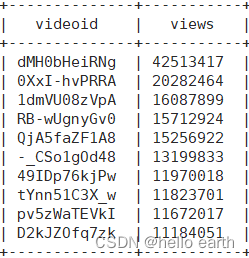对于给定的video日志数据,先利用mapreduce程序进行数据清洗,把数据的存储格式按我们的要求存入文件。
一、数据清洗代码
mapper端对数据清洗后直接输出,不需要reduce阶段
复制代码
1
2
3
4
5
6
7
8
9
10
11
12
13
14
15
16
17
18
19
20
21
22
23
24
25
26
27
28
29
30
31
32
33
34
35
36
37
38
39
40
41
42
43
44
45
46
47
48
49
50
51
52public class ETLMapper extends Mapper<LongWritable, Text,Text, NullWritable>{ private Counter pass; private Counter fail; private StringBuilder sb = new StringBuilder(); private Text result = new Text(); @Override protected void setup(Mapper<LongWritable, Text, Text, NullWritable>.Context context) throws IOException, InterruptedException { pass = context.getCounter("ETL", "Pass"); fail = context.getCounter("ETL","Fail"); } /**日志样例:SDNkMu8ZT68 w00dy911 630 People & Blogs 186 10181 3.49 494 257 rjnbgpPJUks * 将一行的日志进行处理,字段不够的抛弃,将第四个字段中的空格去掉,将最后的相关视频的分隔符改成‘&’ * @param key 行偏移量 * @param value 这行内容 * @param context * @throws IOException * @throws InterruptedException */ @Override protected void map(LongWritable key, Text value, Mapper<LongWritable, Text, Text, NullWritable>.Context context) throws IOException, InterruptedException { //一行数据 String line = value.toString(); //这样切分会把最后一个字段的数据切开,需要最后做拼接 String[] fields = line.split("t"); //每一行数据都会进入map一次,sb是可变字符串,所以每次进来需要清零。 sb.setLength(0); //先判断字段个数够不够 if (fields.length >= 9){ //去掉第四个字段的空格(视频标签字段的数组用&连接) 样例:People & Blogs fields[3] = fields[3].replace(" ",""); //拼接字段 for (int i = 0; i < fields.length; i++) { if (i == fields.length-1){ //相关视频的最后一个,不用做处理,直接添加 sb.append(fields[i]); }else if (i <= 8){ //前九个字段之间用t隔开 sb.append(fields[i]).append("t"); }else{ //相关视频字段用&隔开 sb.append(fields[i]).append("&"); } } result.set(sb.toString()); context.write(result,NullWritable.get()); pass.increment(1); }else { //如果字段不够,舍弃不要 fail.increment(1); } } }
driver端
复制代码
1
2
3
4
5
6
7
8
9
10
11
12
13
14
15
16
17
18
19
20
21
22
23
24
25
26public class ETLToolDriver { public static void main(String[] args) throws Exception { Configuration conf = new Configuration(); //使用tez引擎 // conf.set("mapreduce.framework.name","yarn-tez"); Job job = Job.getInstance(conf); job.setJarByClass(ETLToolDriver.class); job.setMapperClass(ETLMapper.class); job.setNumReduceTasks(0); job.setMapOutputKeyClass(Text.class); job.setMapOutputValueClass(NullWritable.class); FileInputFormat.setInputPaths(job, new Path(args[0])); FileOutputFormat.setOutputPath(job, new Path(args[1])); boolean b = job.waitForCompletion(true); System.exit(b ? 0 : 1); } }
①程序编写完成后,现在本地模式下跑一遍看看有没有问题,没问题的话,直接打包上传到集群
②将要清洗数据的文件提前上传到hdfs
在hadoop服务器端执行如下代码实现数据清洗
复制代码
1
2
3
4yarn jar /opt/module/hadoop/上传的jar包名 driver类的reference引用 hdfs上的文件目录 清洗后存放的目录 我的代码 yarn jar /opt/module/hadoop/etltool-1.0-SNAPSHOT.jar com.atguigui.etl.ETLToolDriver /gulivideo/video /gulivideo/video_etl
在hive端创建数据库并使用该数据库
复制代码
1
2create database gulivideo; use gulivideo;
创建两张外部表
复制代码
1
2
3
4
5
6
7
8
9
10
11
12
13
14create external table video_ori( videoId string, uploader string, age int, category array<string>, length int, views int, rate float, ratings int, comments int, relatedId array<string>) row format delimited fields terminated by "t" collection items terminated by "&" location '/gulivideo/video_etl';
复制代码
1
2
3
4
5
6create external table user_ori( uploader string, videos int, friends int) row format delimited fields terminated by "t" location '/gulivideo/user';
在创建两张内部表并添加数据到内部表
复制代码
1
2
3
4
5
6
7
8
9
10
11
12
13
14
15create table video_orc( videoId string, uploader string, age int, category array<string>, length int, views int, rate float, ratings int, comments int, relatedId array<string>) row format delimited fields terminated by "t" collection items terminated by '&' stored as orc tblproperties("orc.compress"="snappy");
复制代码
1
2
3
4
5
6
7create external table user_orc( uploader string, videos int, friends int) row format delimited fields terminated by "t" stored as orc tblproperties("orc.compress"="snappy");
复制代码
1
2insert into table video_orc select * from video_ori; insert into table user_orc select * from user_ori;
需求①:统计视频播放量Top10
复制代码
1
2
3
4
5
6
7select videoid,views from video_orc order by views desc limit 10;

需求②:统计视频类别热度Top10
复制代码
1
2
3
4
5
6
7
8
9
10
11
12
13
14
15
16
17
18
19
20
21
22第一步:把类别字段的数组炸开 select videoid,cate from video_orc lateral view explode(category) tbl as cate; 第二步:根据第一步的结果,分类统计各个类别的数目并作排序输出目标数据 select cate,count(videoid) as counter from( select videoid,cate from video_orc lateral view explode(category) tbl as cate) tbl group by cate order by counter desc limit 10;

需求③:统计视频观看数最高的20个视频的所属类别以及类别包含Top20视频的个数
复制代码
1
2
3
4
5
6
7
8
9
10
11
12
13
14
15
16
17
18
19
20
21
22
23
24
25
26
27
28
29
30
31
32
33
34
35
36第一步:统计观看数最高的20个视频以及类别 select videoid,category,views from video_orc order by views desc limit 20; //第二步:根据①的结果,将category炸开。 select cate,videoid from( select videoid,category,views from video_orc order by views desc limit 20) t1 lateral view explode(category) tbl as cate; 第三步:按照炸开后的类别分组,统计个数 select cate,count(videoid) n from( select cate,videoid from( select videoid,category,views from video_orc order by views desc limit 20) t1 lateral view explode(category) tbl as cate ) t2 group by cate order by n desc;

需求④:统计视频观看数Top50 所关联视频的所属类别排序
复制代码
1
2
3
4
5
6
7
8
9
10
11
12
13
14
15
16
17
18
19
20
21
22
23
24
25
26
27
28
29
30
31
32
33
34
35
36
37
38
39
40
41
42
43
44
45
46
47
48
49
50
51
52
53
54
55
56
57
58
59
60
61
62
63
64
65
66
67
68
69
70
71
72
73
74
75
76
77
78
79
80
81
82
83
84
85
86
87
88
89第一步:统计Top50的关联视频 select videoid,views,relatedid from video_orc order by views desc limit 50; 第二步:炸开相关视频的数组 select explode(relatedid) videoid from( select videoid,views,relatedid from video_orc order by views desc limit 50 ) t1; 第三步:和原表join获取category select distinct t2.videoid,v.category from( select explode(relatedid) videoid from( select videoid,views,relatedid from video_orc order by views desc limit 50 ) t1 ) t2 join video_orc v on t2.videoid=v.videoid; 第四步:炸开第三步中得到的category select videoid,cate from( select distinct t2.videoid,v.category from( select explode(relatedid) videoid from( select videoid,views,relatedid from video_orc order by views desc limit 50 ) t1 ) t2 join video_orc v on t2.videoid=v.videoid ) t3 lateral view explode(category) tbl as cate; 第五步:将第四步的结果按照cate分组并计数排序后输出 select cate,count(videoid) n from( select videoid,cate from( select distinct t2.videoid,v.category from( select explode(relatedid) videoid from( select videoid,views,relatedid from video_orc order by views desc limit 50 ) t1 ) t2 join video_orc v on t2.videoid=v.videoid ) t3 lateral view explode(category) tbl as cate ) t4 group by cate order by n desc;

需求⑤:统计每个类别中的视频热度Top10,以music为例
复制代码
1
2
3
4
5
6
7
8
9
10
11
12
13
14
15
16
17
18
19
20//创建一张中间表格,把category字段炸开 create table video_category stored as orc tblproperties("orc.compress"="snappy") as select videoid,uploader,age,cate,length,views,rate,ratings,comments,relatedid from video_orc lateral view explode(category) tbl as cate; //从中间表格查询 select videoid,views,cate from video_category where cate='Music' order by views desc limit 10;

需求⑥:统计每个类别中视频流量Top10,以Music为例
复制代码
1
2
3
4
5
6//直接在需求⑤生成的中间表查询 select videoid,ratings from video_category where cate='Music' order by ratings desc limit 10;

需求⑦:统计上传视频最多的用户Top10 以及他们上传的观看次数在前20的视频
理解一:Top用户和他们的播放量Top20
复制代码
1
2
3
4
5
6
7
8
9
10
11
12
13
14
15
16
17
18
19
20
21
22
23
24
25
26
27
28
29
30
31
32
33
34
35
36
37
38
39第一步:统计上传视频数Top10 select uploader,videos from user_orc order by videos desc limit 10; 第二步:和video_orc表join查看这些用户都上传了哪些视频和视频观看数 select t1.uploader,v.videoid, rank() over(partition by t1.uploader order by v.views desc) hot from( select uploader,videos from user_orc order by videos desc limit 10 ) t1 left join video_orc v on t1.uploader = v.uploader; 第三步:根据第二步的结果排序 select t2.uploader,t2.videoid,t2.hot from( select t1.uploader,v.videoid, rank() over(partition by t1.uploader order by v.views desc) hot from( select uploader,videos from user_orc order by videos desc limit 10 ) t1 left join video_orc v on t1.uploader = v.uploader ) t2 where t2.hot <= 20;
理解二: 播放量Top20哪些是由上传量Top10用户上传的
复制代码
1
2
3
4
5
6
7
8
9
10
11
12
13
14
15
16
17
18
19
20
21
22
23
24
25
26
27
28
29
30
31
32
33
34
35//上传量Top10用户 select uploader,videos from user_orc order by videos desc limit 10; //播放量Top20 select videoid,uploader,views from video_orc order by views desc limit 20; //两表join查看 select t1.uploader,t2.videoid,t2.views from( select uploader,videos from user_orc order by videos desc limit 10 ) t1 left join ( select videoid,uploader,views from video_orc order by views desc limit 20 ) t2 on t1.uploader=t2.uploader;
需求⑧:统计每个类别视频的观看数Top10
复制代码
1
2
3
4
5
6
7
8
9
10
11
12
13
14
15
16//从video_category表中查videoid,views和按类别分组的播放量排名 select cate,videoid,views, rank() over(partition by cate order by views desc) hot from video_category; //从①的结果中输出各个类别的播放量Top10 select cate,videoid,views from( select cate,videoid,views, rank() over(partition by cate order by views desc) hot from video_category ) t1 where hot <= 10;
最后
以上就是留胡子煎饼最近收集整理的关于hive实战——谷粒影音一、数据清洗代码的全部内容,更多相关hive实战——谷粒影音一、数据清洗代码内容请搜索靠谱客的其他文章。
本图文内容来源于网友提供,作为学习参考使用,或来自网络收集整理,版权属于原作者所有。








发表评论 取消回复